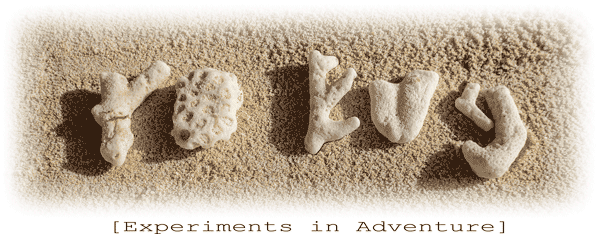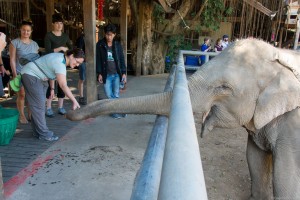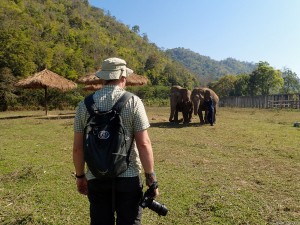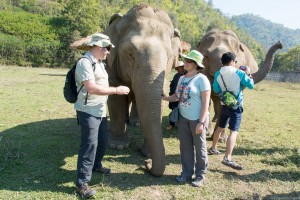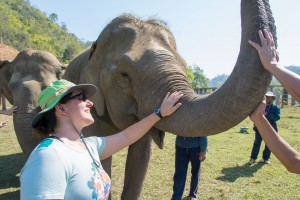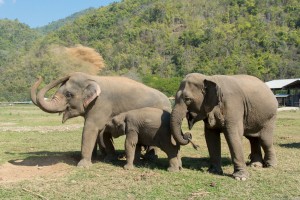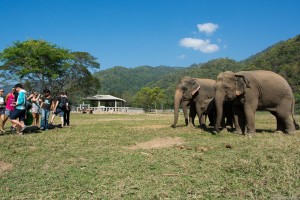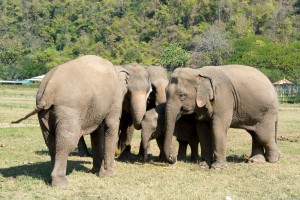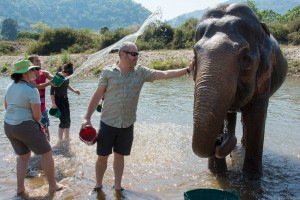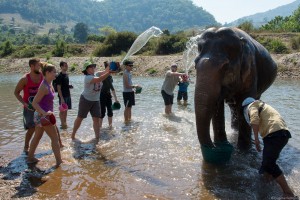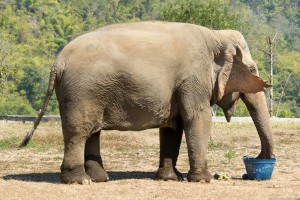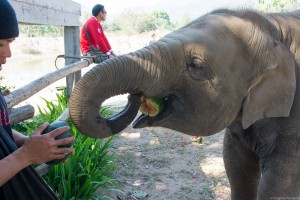For the first 2 weeks in Thailand Eugene kept asking “So where are the elephants?”. Save for tourists in elephant pants, we saw none. So once we got to Chiang Mai, we went in search of “happy” elephants. We weren’t quite sure what we meant by that, but knew that seeing them in as natural a setting as possible was part of it.
We had already been asking around about the best place to go and our Sukhothai bike tour guide had suggested either Elephant Nature Park or Patara Elephant Farm. We did quite a bit of research and decided we wanted a place that did not include riding on the animals, so we chose to go to Elephant Nature Park and we’re very glad we did.
Like every tourist activity run out of Chiang Mai, we were picked up from our hotel, bright and early in a bus minivan. During the hour drive north into the mountains, we watched a safety video all about how to not get trampled, kicked, or whacked by an elephant. We also learned that the Park rescues animals that have worked in the logging (technically illegal in Thailand, but not Myanmar) or in the tourist industry. In addition, some of the elephants are orphaned babies from the wild or in captivity.
We arrived at the Park, excited to have already glimpsed a few elephants in the distance during the drive. We started our visit with a chance to feed an elephant from a platform. To do so, you hold the piece of fruit up to the side of its remarkably strong trunk. Our elephant, who was blind, from old age and too many tourist camera flashes in its past, had a breakfast of watermelon and pumpkin. While feeding was fun, I found it even more enjoyable to just watch them eat. Their use of their trunk to feel, smell, and eat was incredible.
- Feeding time!
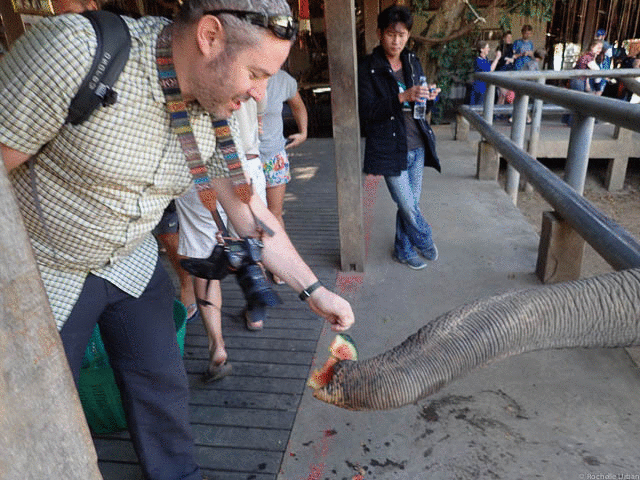
After feeding time, we went out for a walk on the grounds of the park. I assumed we’d be watching the animals from a far as they elephant-ed around. Much to my surprise, we came right up close to a pair of females with their mahouts (each elephant has a caretaker that is with them all the time). Being so close to an elephant, actually touching their skin and feeling the muscle in their trunks was an exhilarating and awe-inspiring experience.
- How close I thought we’d get.
- We got amazingly up-close and personal with the elephants!
- Apparently this elephant loves to have people touch his trunk and raise it up
We learned that of the dozens of elephants that live at the park, most are female (they have very few males that have to live separately as they usually live by themselves in the wild) and they have made their own social groups. Some stay in larger families, others in twos or threes, and some prefer to be on their own (especially since they may have come from an environment where they never socialized with other elephants).
The family groups were by far the most captivating. These feel like watching the most natural of behaviors. Mothers, grandmothers, and “nannies” all help take care of their young. Juvenile elephants are very playful and you need to keep your distance lest they decide to be playful with you. We watched one nanny (a non-related female that takes on helping the mother raise the young) get threatened by a group of elephants from a riding camp across the river and charge at them. Because mahouts at the park do not use hooks or any other violent means to control the animals, the only way to calm this elephant down was to lead its baby nearer to distract her. We were so distracted by the commotion that we didn’t think to start recording until the elephant came running back.
While the elephants were incredible, it was disturbing just how many animals were there because of human violence. Some elephants we saw had crippled legs because they’d stepped on land mines that are scattered near the Burmese border (set by minority groups that don’t want the government on their land.) Another had been deformed when a car hit her and yet another had a broken back from too much riding. Another was blind because its previous owners would hit it in the eyes when it refused to work. There was even a baby had been orphaned when his wild mother was shot. But luckily, they have pretty good veterinary care. We watched an elephant being given antibiotics through the largest I.V. bag I’ve ever seen.
- Mother elephant applies natural sunscreen while baby eats
- One of the family groups and a tourist group
- Baby elephant! You can see the bum leg on the right-most animal (land mine)
We were fed a tasty vegetarian lunch (the founder, Lek, cares about rescuing animals and also “saves” buffalo from the slaughterhouse). Then we watched a Nat Geo special on the sanctuary (lots of heart-string pulling). In a rather graphic way, we watched how young elephants have their “spirit broken” to be work animals. The practice of Phajaan, we were told involves constraining the animal for days while it is beaten. While there are modern ways of training elephants using positive reinforcement, the villages where most elephants are trained are still using the same cruel methods they’ve been using for centuries.
After the film, we also got a chance to help bathe the animals, which was really just throwing buckets of river water on the animals. This felt the most contrived of all the things we did that day and when the elephants were being bribed with food to behave for the tourists. But it was still another chance to interact with the amazing creatures.
- Best way to keep an elephant happy at bathtime: lots of bananas.
- Splash! (and yes, Rochelle missed)
- It’s always feeding time!
- Baby elephant hasn’t quite mastered eating a whole melon
So we were left with two big questions: “did we really see happy elephants?” and “would we tell people to avoid riding elephants on their trips to Southeast Asia?”
Let’s start with riding. More so after our day with the animals, Eugene and I are certain we will never be okay with getting on the back of an elephant in a seat or bareback. Given the “spirit-breaking” regimen that young elephants are put through to be docile enough to carry a rider, we feel that supporting companies that allow riding would be perpetuating the practice. Besides, we had plenty of up close and personal time with animals without being on their backs. But what would we suggest to others? Our best advice is to do your research, make sure that you are supporting practices with which you are comfortable. Since there are so few wild elephants left in Thailand and there is little hope that the population will recover, perhaps the only way to financially support those in captivity is to continue to support responsible riding camps.
And did we see happy elephants? You might say some of the animals we saw were likely very unhappy given the reasons they’d been brought to the Park. Being blinded, having a broken back, being beaten until they worked, or simply being abandoned — does not really meet our definition of happy. But the fact that many of the animals have formed new social groups, wander freely, and are well fed with plenty of medical help they may have better lives now than some human residents of Thailand — so they’re certainly better off. And of course who’s to say if an animal is truly “happy” or even capable of it. Sounds like a good question for a second PhD thesis…and not that far from one having to do with mice feeling chronic pain…
